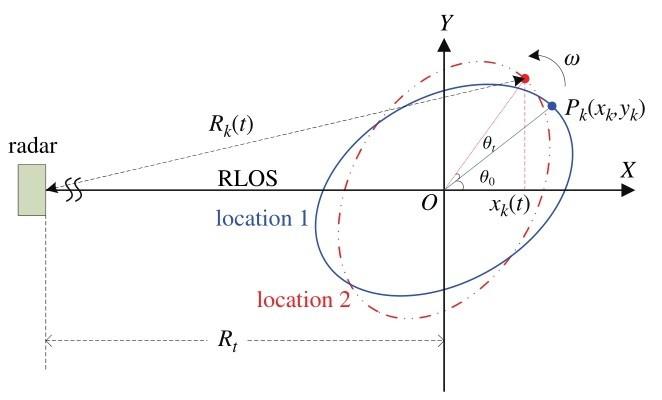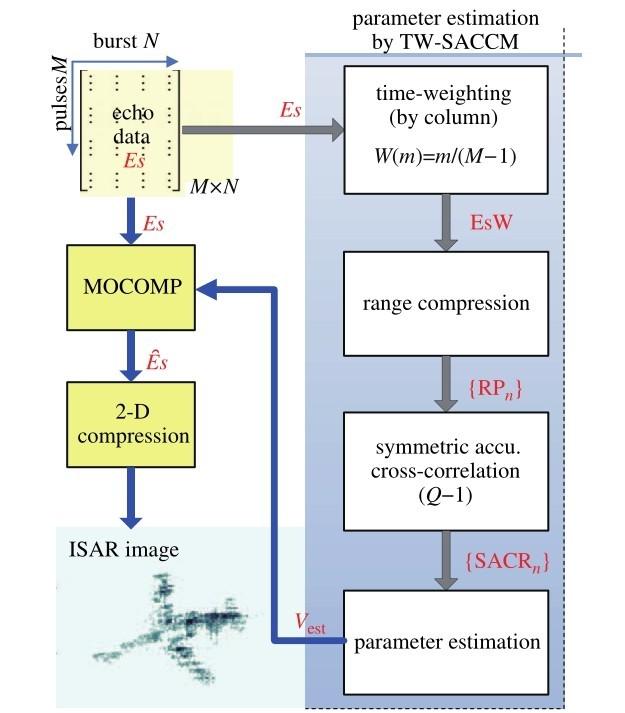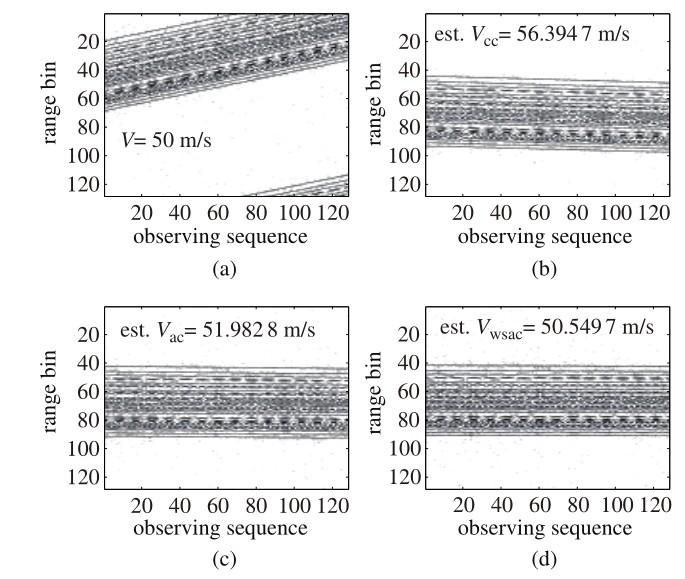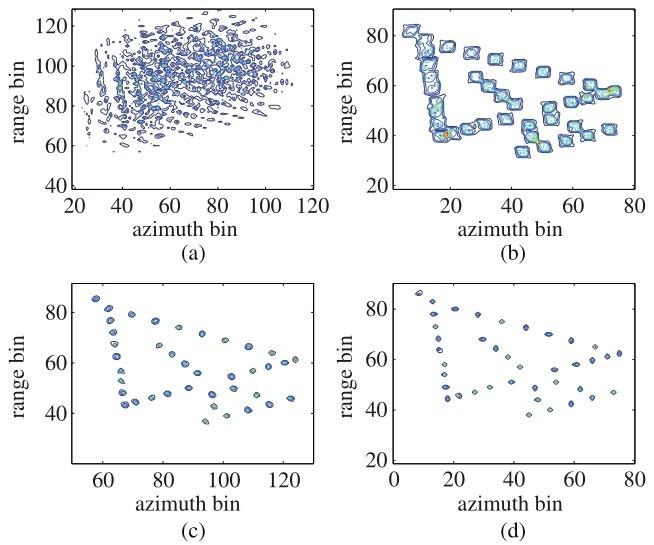Ⅰ. INTRODUCTION
I nverse synthetic aperture radar (ISAR) utilizes the rela-tive motion between the target and the radar to expand the space aperture during coherent processing interval (CPI) to realize two-dimensional(2-D)imaging[1,2]. To meet the high resolution requirements in range dimension, the ISAR system typically emits a set of LFM(Chirp)signals or step frequency (SF) signals with large time-bandwidth products. Thus, the echo signal can be approximated as a linear combination of multicomponent Chirp signals, and its range profile appears as the combination of multiple expanded spectrums accordingly. The implementation of ISAR imaging is primarily based on the conventional range-Doppler (RD) algorithm[3], and the motion compensation(MOCOMP)[4]is the key procedure of the RD algorithm. Because only if profiles are aligned in range dimension, the scattering points can be distinguished in azimuth direction[5].
Common MOCOMP algorithms can be classified into two types. One is based on strong scattering points of the target[5,6,7,8,9]. But according to the analysis of practical test data, it is difficult to stably track interested points during the whole dwelling time. So the application of such algorithms is not very wide in practice. The other is based on cross-correlation processing of adjacent echoes, such as the cross-correlation method(CCM)[10], the accumulated cross-correlation method (ACCM)[11], and the cross-correlation method based on the fractional Fourier transform (FrFT)[12,13,14] range compression and so on.
The CCM assumes small and relatively constant range shifts between adjacent range profiles. However, in reality, many factors may result in random noises in the echo signals. For instance, the target with built-in disturbance components or the case under an extremely poor flying situation. In these cases, the sharply fluctuated and multi-peaked range profiles will increase the number of serious aligned errors. Additionally, the aligned errors of different range profiles may be transferred and accumulated during the cross-correlation processing. The ACCM uses the accumulation concept to enhance the stable and strong frequency components in the profile of each echo signal and to suppress the fast varying disturbances, which reduces the aligned error to some extent. Nevertheless, the common problem is still not solved, because the complex envelopes of the original range profiles may introduce more than one peak values on the cross-correlation curves and then import aligned errors especially in hostile environments. In addition, the phase error caused by the simplex accumulation manner should not be ignored. To reduce the aligned errors from the perspective of signal form optimization, Ref. [14]proposed a cross-correlation method based on the FrFT range compression(FrCCM). This method uses the FrFT property to aggregate the Chirp signal power into a very sharp single peak in a certain matched-order domain. However, as its good estimation performance requires a high-precision matched-order, searching for the matched-order inevitably leads to severely increased computational complexity.
Figure 1
Figure 1
Geometry of ISAR system
To eliminate the aligned errors introduced by the complex envelopes of the range profiles and to ensure an acceptable computational complexity simultaneously, we propose a symmetric accumulated cross-correlation method of parameter estimation based on time-weighting range compression (TWSACCM). The proposed method maps the range profile of a single scattering point into a well-aligned single peak by the time-weighting processing. Meanwhile, it improves the accumulation manner by applying a symmetric accumulation scheme to offset the phase error. Simulation results demonstrate the better performance of the proposed method compared to other similar algorithms, and the computational complexity is much lower than that of the method based on FrFT.
Ⅱ. SIGNAL MODEL FOR MOCOMP
Conventionally, in radar imaging, the observing target is often considered as an aggregation of strong scattering points, and the phase center is generally selected as the geometry center of the target. A simplified geometry of the ISAR system is shown in Fig.1.
The X axis, in the direction of the radar line of sight (RLOS), is assumed to be along the radial direction, while the Y axis is in the azimuthal direction. Therefore, the baseband echo signal can be described as
where Rt is the instantaneous range from the phase center of the target to the radar, and can be eliminated via translational MOCOMP. (xk, yk)represent the Cartesian coordinates of the scattering point Pk. ft is the instantaneous frequency, and θt is the instantaneous rotation angle.
Considering observations of small rotation angles(less than 5°)during the CPI, a pair of approximate expressions as follows can be used:
To form a 2-D ISAR image, the frequency diversity in the fast-time dimension and the angle diversity in the slow-time dimension are utilized. Assuming that the step frequency radar transmits a sequence of N bursts, and that each burst consists of M narrow frequency band pulses with pulse repetition interval(PRI)Tr, the discrete echo data can be arranged into a 2-D data array as shown in Eq. (3)
where v1 is the velocity component along the RLOS. It is shown that besides the two Fourier transformation pairs xk∼2 ft/c in the fast-time dimension and yk ∼θt · 2 f/c in the slow-time dimension, an extra phase term caused by the radial movement of the target exists:
This phase term conducts the range shift along azimuthal direction with the parameter v1, and would cause the misalignment among range profiles and further lead to blurring during azimuthal compression processing. Therefore, to gen erate a focused ISAR image, parameter estimation and MOCOMP processing must be performed to eliminate the phase term shown in Eq. (4).
In the application details, the baseband echo signal s(t)is sampled at t=(m+nM)Tr, where m=0, …, M−1 and n=0, …, N−1 represent the indexes in the fast and slow time dimensions, respectively. During the fast time period,
Here TB=MT r is the time interval between two bursts. Thus, sr(m)is shown as a combination of a set of Chirp signals with the equivalent Chirp rate µ=v1Tr. The equivalent center frequency of each component, corresponding to the radial coordinate of each scattering point, is
Ⅲ. PRINCIPLES OF THE TW-SACCM
The primary purpose of the proposed method in this paper is to reduce parameter estimation errors to improve the MOCOMP performance. Based on the previous introduction, the two primary principles of the proposed method including the time-weighting principle and the symmetric accumulation manner are introduced in this section.
A. Time-Weighting Range Compression
Consider a Chirp signal
where
Here the coefficient function is
Fig.2 shows the spectra of the original signal(with the initial frequency f0=20 Hz)and its time-weighted signal. The spectrum of the Chirp signal is modulated into a single-peaked envelope by a linear function A(ω)after the time-weighting processing. In addition, the modulation function slope depends on the Chirp rate k2, and the zero position on the frequency axis corresponds to the initial frequency of the Chirp signal.
In regards to the echo signal in the range dimension as shown in Eq. (5), the time-weighting processing can be applied to the range compression in ISAR imaging to find the trip point Fk and to generate an envelope with only one sharp peak. Thus, the aligned error could be effectively reduced by means of optimizing the signal waveforms. Further, the timeweighting range compression only introduces little computational complexity of O(M).
Figure 2
Figure 2
Spectrum of time-weighted Chirp signal
B. Symmetric Accumulation Cross-Correlation Processing
To solve error transfer and accumulation by the CCM, the ACCM utilizes the accumulation concept. It sums up the Z−1 cross-correlations generated by the current range profile with its Z−1 previous range profiles. In the actual discrete data processing, the cross-correlation can be calculated fast via computing the convolution. By denoting the range profile of the nth burst as RPn, the cross-correlations of the CCM can be given as
and the accumulated cross-correlation of the ACCM is
Here, ()∗denotes conjugation. The accumulation concept has been proved to be effective; however, the accumulated crosscorrelation processing still contains phase errors caused by the simplex accumulation manner. Therefore, an improved symmetric accumulation manner is proposed herein. It produces the cross-correlation by accumulating both the forward and the backward range profiles of the reference, which can be expressed as
where Q=ceil(Z/2), i. e. , Q is an integer by rounding up the one-half of Z, such that the accumulation number of the proposed method is equivalent to that of the ACCM. Subsequently, both the positive and negative phase errors of the current range profiles can be offset symmetrically.
Ⅳ. MOCOMP VIA TW-SACCM
For most imaging algorithms, MOCOMP is an important procedure. Generally, high-precision MOCOMP facilitates in generating high-quality ISAR images. According to the advantages of the TW-SACCM for range compression and the cross-correlation processing introduced in section Ⅲ, we can use the TW-SACCM for MOCOMP in ISAR processing. The implementation of the TW-SACCM can be described as
Algorithm 1 TW-SACCM
1: Sample the baseband echo signal to form the data array Es in the size of M×N.
2: Construct the normalized weighting vector in the length of M (i. e. , the same size with the sample number in the range dimension):
W(m)=m/(M−1), m=0, 1, 2, ···, M−1.
3: Implement weighting processing to the raw data Es by column, and generate the time-weighted data array:
EsW(: , n)=W(m)∗Es(: , n).
4: Perform range compression on EsW and obtain the collection of the N range profiles, denoted as{RPn}.
5: Select an appropriate accumulation number Q and perform the symmetric accumulation cross-correlation processing to the obtained{RPn}, and obtain a set of symmetric accumulated cross-correlations{SACRnˆ}, where the index
6: Search the peak values of the obtained{SACRnˆ}, and smooth out the outburst values by the robust locally weighted scatterplot smoothing (LOWESS)method[15]; and estimate the average range shift∆R.
7: Obtain the estimated velocity by Vest=∆R/TB.
Based on the conventional MOCOMP processing, we combine the TW-SACCM as the parameter estimation scheme with the RD algorithm. Fig.3 shows the flow chart of the proposed method applied for MOCOMP in ISAR imaging.
Figure 3
Figure 3
Flow chart of TW-SACCM application
Ⅴ. SIMULATION RESULTS
To verify the effectiveness of the proposed method, numerical simulations are carried out.
•Test 1: Effectiveness of time-weighting range compression.
Fig.4(a) and(b)compares the results of two range profiles compressed by the conventional Fourier transform and the Time-Weighting method, respectively. The initial signal consists of two Chirp components. Their frequency positions are f1=10 Hz and f2=25 Hz, corresponding to two scattering points. Further, the SNR is−3 dB.
Fig.5 shows their cross-correlation curves of the adjacent range profiles. The broad spectrum corresponding to each single scattering point presents a very noisy multi-peak envelope. This undoubtedly causes large errors to the range alignment, while the profile generated by the time-weighting range compression presents the scattering points clearly. Furthermore, the cross-correlation curves in Fig.5 also verifies that the curve produced by the time-weighting method is much more smoother and sharper, and the cross terms are also well suppressed.
•Test 2: Effectiveness of offsetting phase error.
Based on Test 1, Fig.6 shows the range-shift results of three cross-correlation curves obtained by the CCM, ACCM,
Figure 4
Figure 4
Range profiles: (a)by FT; (b)by time-weighting method
Figure 5
Figure 5
Cross-correlations of adjacent profiles
FrCCM, and the proposed TW-SACCM, respectively. The initial signal includes three Chirp components with frequencies of f1=10 Hz, f2=18 Hz, and f3=25 Hz. As shown in Fig.6(a), a large range shift error exists between the two adjacent curves; the range shifts in Fig.6(b)appear much more uniform; however, the curves present multipeak envelopes caused by the accumulated phase error and the cross terms of the cross-correlation processing; by utilizing the FrFT, the extremely pointy envelopes are generated, as shown in Fig.6(c), and most of the cross terms are suppressed. However, false peaks may be introduced by the phase errors. Fig.6(d)shows a set of single-peak smooth curves, in which, the cross terms as well as the noise levels are suppressed very well. It is noteworthy that the range shifts show good uniformity, which illustrates the efficiency of the proposed method.
•Test 3: Performance analysis of TW-SACCM.
This experiment compares the performance of several parameter estimation methods based on cross-correlation processing from the perspectives of effectiveness and cost.
Table 1 Simulation parameters of ISAR system
| target | f0(GHz) | B(MHz) | PRF(kHz) | M | N | Z |
| triangle | 10 | 128 | 20 | 128 | 128 | 8 |
| Yak-42 | 5.52 | 400 | 0.4 | 256 | 256 | 16 |
Table 2 Image entropy
| method | No. | CCM | ACCM | TW-SACCM |
| Fig.10 | 3.6572 | 3.1667 | 2.6797 | 2.4973 |
| Fig.11 | 3.5679 | 2.7462 | 2.7216 | 2.6991 |
According to our results, the proposed method is superior to other methods of the same kind. It is noteworthy that the FrCCM yields worse RMSE performance than the ACCM despite the energy focus property of the FrFT. This is because the estimation performance of the FrCCM is extremely sensitive to the accuracy of the matched FrFT order, and both accuracy and complexity are difficult to meet simultaneously in practical applications. In addition, the experiment also yields the RMSE of the traditional ACCM combined with the timeweighting technique (TW-ACCM) as a comparison. Therefore, two conclusions can be drawn as follows.
• The performance of the TW-ACCM is superior to that of the ACCM, which verifies the effectiveness of the timeweighting processing.
• The performance of the TW-ACCM is inferior to the TW-SACCM, which verifies the effectiveness of the symmetric accumulation processing.
Additionally, Fig.8 shows the computational complexity curves of different methods. Further, the corresponding expressions of the computational complexity are shown in Tab.3. In conclusion, the computation cost of the TWSACCM and the ACCM are almost the same; however, the RMSE of the TW-SACCM is much smaller than that of the ACCM.
Figure 6
Figure 6
Cross-correlations of range profiles by different MOCOMP methods: (a)by CCM; (b)by ACCM; (c)by FrCCM; (d)by TW-SACCM
Figure 7
Figure 7
RMSE of parameter estimation methods
To summarize, the proposed method has better estimation performance but lower computational complexity than other similar methods.
Figure 8
Figure 8
Computational complexity curve
•Test 4: Application of TW-SACCM in ISAR imaging.
In regards to the practical applications in ISAR imaging, Fig.9 shows the range compression spectrograms of the echo data by no MOCOMP, and by MOCOMP based on CCM, ACCM and TW-SACCM. The radar system transmits step frequency signals and the SNR=−5 dB; the other parameters are the same as those in Test 3. The first subgraph clearly demonstrates the progressive range shift during the integration time of the ISAR processing.
Table 3 Computational complexity expression
| method | complexity |
| CCM | O?4MNlbM? |
| ACCM | O?MNlbM+3ρ(1−ρ)MN2lbM? |
| FrCCM | O?PMN(lbM+2)+3MNlbM? |
| TW-SACCM | O?MN(lbM+1)+3ρ(1−ρ)MN2lbM? |
Figure 9
Figure 9
Comparison results of range compression: (a)no MOCOMP; (b) CCM-MOCOMP; (c)ACCM-MOCOMP; (d)TWSACCM-MOCOMP
If a successful MOCOMP practice is applied, no(or minimal)range shift between consecutive burst intervals can be expected. Therefore, three different MOCOMP methodologies are applied to the raw data and three other compensated figures are generated, as shown in Fig.9. As shown in these spectrograms, the range delays caused by the target movement have been eliminated and the range profiles have been aligned. In particular, the aligned performance of the fourth subgraph is the best owing to the minimum estimation error by the TWSACCM.
The ISAR images of the hypothetical target and the real Yak-42 obtained by different MOCOMP methods are shown in Fig.10 and Fig.11, respectively. The velocity of Yak42 is 210 m/s, and other parameters are listed in Tab.1. To evaluate the image quality quantitatively, Tab.2 illustrates the image entropy values. It is shown that for both the numerically simulated data and the real measured data, the proposed method shows the smallest entropy, which indicates that the image generated by the TW-SACCM is more focused.
Figure 10
Figure 10
ISAR images of the hypothetical target: (a)no MOCOMP; (b) CCM-MOCOMP; (c)ACCM-MOCOMP; (d)TWSACCM-MOCOMP
Figure 11
Figure 11
ISAR images of Yak-42: (a) no MOCOMP; (b) CCM; (c) ACCM; (d)TWSACCM
Ⅵ. CONCLUSION
Herein, a time-weighting symmetric accumulated crosscorrelation method of parameter estimation for ISAR MOCOMP is proposed. The proposed method utilizes the timeweighting technique to map the broad spectrum of the Chirp signal into a single-peak envelope, which lays an important foundation for optimizing the waveform of the range profiles and improving the alignment performance. In addition, the proposed method uses an optimized symmetric accumulation cross-correlation scheme to offset the positive and negative phase errors produced by the forward and the backward accumulation processing. The effectiveness of the proposed method is verified by both theoretical derivations and related simulations. Compared with other similar methods, the proposed method performs better estimation accuracy, yields fewer estimation errors, and ensures low computation complexity.
Reference
Synthetic aperture radars
[J].
Inverse synthetic aperture technology aids radar identification of ships
[J].
Range-Doppler imaging of rotating objects
[J].
Translational motion compensation in ISAR image processing
[J].
The application of motion compensation of ISAR image for a moving target in radar target recognition
[J].
Target-motion-induced radar imaging
[J].
Range-Doppler imaging and multiple scatterpoint location
[J].
Motion compensation for ISAR via centroid tracking
[J].
Robust centroid target tracker based on new distance features in cluttered image sequences
[J].
Motion compensation for ISAR imaging
[C]//
A novel range alignment algorithm for real time ISAR imaging
[C]//
Fractional Fourier transform as a signal processing tool: an overview of recent developments
[J].
Research progress of the fractional Fourier transform in signal processing
[J].
An improved cross-correlation approach to parameter estimation based on fractional Fourier transform for ISAR motion compensation
[C]//
Robust locally weighted regression and smoothing scatterplots
[J].



















